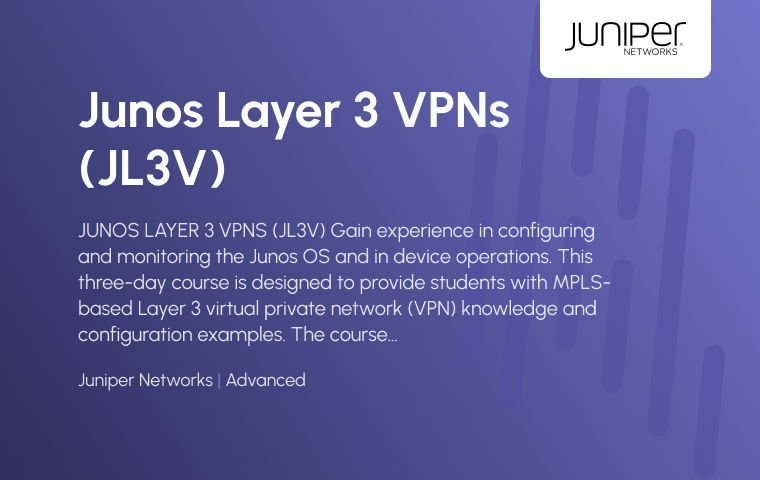
Junos Layer 3 VPNs (JL3V)
This three-day course is designed to provide students with MPLS-based Layer 3 virtual private network (VPN) knowledge and configuration examples. The course includes an overview of MPLS Layer 3 VPN concepts, scaling Layer 3 VPNs, Internet access, Interprovider Layer 3 VPNs, and Multicast for Layer 3 VPNs. This course also covers Junos operating system-specific implementations of Layer 3 VPNs.
These concepts are put into practice with a series of in-depth hands-on labs, which will allow participants to gain experience in configuring and monitoring Layer 3 VPNs on Junos OS devices. These hands-on labs utilize Juniper Networks vMX Series devices using the Junos OS Release 19.4R1.10, and are also applicable to other MX Series devices.
Virtual Classroom Live
Prerequisites
- Intermediate-level networking knowledge and an understanding of OSPF, ISIS, BGP, and Junos policy
- Experience configuring MPLS label-switched paths using Junos
- Attend the Introduction to the Junos Operating System (IJOS), Junos Intermediate Routing (JIR), and Junos MPLS Fundamentals (JMF) courses prior to attending this class
Target Audience
What You’ll Learn
Course Outline
Labs Outline
Related Certifications
- Describe the value of MPLS VPNs.
- Describe the differences between provider-provisioned VPNs and customer- provisioned VPNs.
- Describe the differences between Layer 2 VPNs and Layer 3 VPNs.
- List the provider-provisioned MPLS VPN features supported by the Junos OS software.
- Describe the roles of a CE device, PE router, and P router in a BGP Layer 3 VPN.
- Describe the format of the BGP routing information, including VPN- IPv4 addresses and route distinguishes.
- Describe the propagation of VPN routing information within an AS.
- List the BGP design constraints to enable Layer 3 VPNs within a provider network.
- Explain the operation of the Layer 3 VPN data plane within a provider network.
- Create a routing instance, assign interfaces to a routing instance, create routes in a routing instance, and import/export routes from a routing instance using route distinguishers/route targets.
- Describe the purpose of BGP extended communities, configure extended BGP extended communities, and use BGP extended communities.
- List the steps necessary for proper operation of a PE-CE dynamic routing protocol.
- List the troubleshooting and monitoring techniques for routing instances.
- Explain the difference between the bgp.l3vpn table and the inet.0 table of a routing instance.
- Monitor the operation of a CE-PE dynamic routing protocol.
- Explain the operation of a PE multi-access interface in a Layer 3 VPN and list commands to modify that behavior.
- Describe ways to support communication between sites attached to a common PE router.
- Provision and troubleshoot hub-and-spoke Layer 3 VPNs,
- Describe the flow of control traffic and data traffic in a hub-and-spoke Layer 3 VPN.
- Describe QoS mechanisms available in L3VPNs.
- Configure L3VPN over GRE tunnels.
- Describe the RFC 4364 VPN options.
- Describe the carrier-of-carriers model.
- Configure the carrier-of-carriers and “Option C” configuration.
- Describe the flow of control and data traffic in a draft-rosen multicast VPN.
- Describe the configuration steps for establishing a draft-rosen multicast VPN.
- Monitor and verify the operation of draft-rosen multicast VPNs.
- Describe the flow of control traffic and data traffic in a next-generation multicast VPN.
- Describe the configuration steps for establishing a next-generation multicast VPN.
- Monitor and verify the operation of next-generation multicast VPNs.
- Describe the flow of control traffic and data traffic when using MPVNs for Internet multicast.
- Describe the configuration steps for enabling internet multicast using MVPNs.
- Monitor and verify the operation of MVPN internet multicast.

